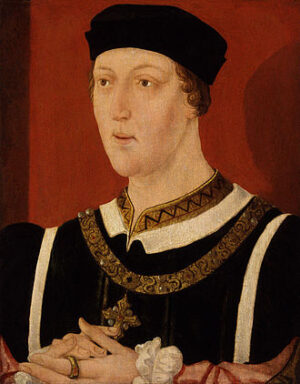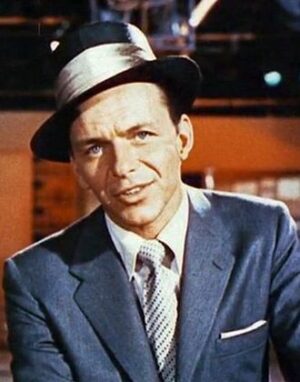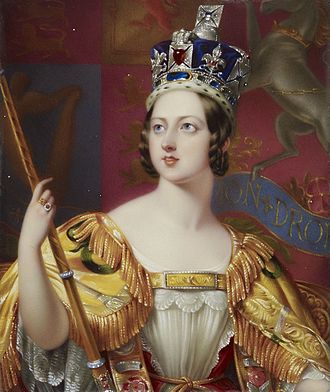
Early Reign
Henry was the only child and heir of King Henry V. He was born on 6 December 1421 at Windsor Castle. He succeeded to the throne as King of England at the age of nine months on 1 September 1422, the day after his father’s death and was the youngest person ever to succeed to the English throne.
On 21 October 1422, in accordance with the Treaty of Troyes of 1420, he became titular King of France upon his grandfather Charles VI’s death. His mother, the 20-year-old Catherine of Valois, was viewed with considerable suspicion by English nobles as Charles VI’s daughter. She was prevented from playing a full role in her son’s upbringing.
On 28 September 1423, the nobles swore loyalty to Henry VI, who was not yet two years old. They summoned Parliament in the King’s name and established a regency council to govern until the King should come of age. One of Henry V’s surviving brothers, John, Duke of Bedford, was appointed senior regent of the realm and was in charge of the ongoing war in France.
During Bedford’s absence, the government of England was headed by Henry V’s other surviving brother, Humphrey, Duke of Gloucester, who was appointed Lord Protector and Defender of the Realm. His duties were limited to keeping the peace and summoning Parliament. Henry V’s uncle Henry Beaufort, Bishop of Winchester (after 1426 also Cardinal), had an important place on the Council. After the Duke of Bedford died in 1435, the Duke of Gloucester claimed the Regency himself, but was contested in this by the other members of the Council.
From 1428, Henry’s tutor was Richard de Beauchamp, Earl of Warwick, whose father had been instrumental in the opposition to Richard II’s reign. For the period 1430–1432, Henry was also tutored by the physician John Somerset. Somerset remained within the royal household until early 1451 after the English House of Commons petitioned for his removal because of his ‘dangerous and subversive influence over Henry VI’.
Henry’s mother Catherine remarried to Owen Tudor and had two sons by him, Edmund and Jasper. Henry later gave his half-brothers earldoms. Edmund Tudor was the father of King Henry VII of England.
In reaction to the coronation of Charles VII of France in Reims Cathedral on 17 July 1429, Henry was soon crowned King of England at Westminster Abbey on 6 November 1429,followed by his own coronation as King of France at Notre Dame de Paris on 16 December 1431. He was the only English king to be crowned king in both England and France.
It was shortly after his crowning ceremony at Merton Priory on All Saints’ Day, 1 November 1437, that he obtained some measure of independent authority. This was confirmed on 13 November 1437, but his growing willingness to involve himself in administration had already become apparent in 1434, when the place named on writs temporarily changed from Westminster (where the Privy Council met) to Cirencester (where the King resided).
He finally assumed full royal powers when he came of age at the end of the year 1437, when he turned sixteen years old. Henry’s assumption of full royal powers occurred during the Great Bullion Famine and the beginning of the Great Slump in England.
French Policies
Henry, who was by nature shy, pious and averse to deceit and bloodshed, immediately allowed his court to be dominated by a few noble favourites who clashed on the matter of the French war when he assumed the reins of government in 1437.
After the death of King Henry V, England had lost momentum in the Hundred Years’ War, whereas the House of Valois had gained ground beginning with Joan of Arc‘s military victories in the year 1429.
The young King came to favour a policy of peace in France and thus favoured the faction around Cardinal Beaufort and William de la Pole, Earl of Suffolk, who thought likewise while the Duke of Gloucester and Richard, Duke of York, who argued for a continuation of the war, were ignored.
Marriage
As the English military situation in France deteriorated, talks emerged in England about arranging a marriage for the king to strengthen England’s foreign connections and facilitate a peace between the warring parties.
In 1434, the English council suggested that peace with the Scots could best be effected by wedding Henry to one of the daughters of King James I of Scotland but the proposal came to nothing. During the Congress of Arras in 1435, the English put forth the idea of a union between Henry and a daughter of King Charles VII of France, but the Armagnacs refused even to contemplate the suggestion unless Henry renounced his claim to the French throne. Another proposal in 1438 to a daughter of King Albert II of Germany likewise failed.
Better prospects for England arose amidst a growing effort by French lords to resist the growing power of the French monarchy, a conflict which culminated in the Praguerie revolt of 1440. Though the English failed to take advantage of the Praguerie itself, the prospect of gaining the allegiance of one of Charles VII’s more rebellious nobles was attractive from a military perspective.
In about 1441, the recently ransomed Charles, Duke of Orléans, in an attempt to force Charles VII to make peace with the English, suggested a marriage between Henry VI and a daughter of John IV, Count of Armagnac, a powerful noble in southwestern France who was at odds with the Valois crown. An alliance with Armagnac would have helped to protect English Gascony from increasing French threats in the region, especially in the face of defections to the enemy by local English vassals and might have helped to wean some other French nobles to the English party.
The proposal was seriously entertained between 1441 and 1443, but a massive French campaign in 1442 against Gascony disrupted the work of the ambassadorsand frightened the Count of Armagnac into reluctance. The deal fell through due to problems in commissioning portraits of the Count’s daughters and the Count’s imprisonment by Charles VII’s men in 1443.
Cardinal Beaufort and the Earl of Suffolk persuaded Henry that the best way to pursue peace with France was through a marriage with Margaret of Anjou, the niece of King Charles VII. Henry agreed, especially when he heard reports of Margaret’s stunning beauty, and sent Suffolk to negotiate with Charles, who consented to the marriage on condition that he would not have to provide the customary dowry and instead would receive the province of Maine from the English.
These conditions were agreed in the Treaty of Tours in 1444 but the cession of Maine was kept secret from Parliament, as it was known that this would be hugely unpopular with the English populace. The marriage took place at Titchfield Abbey on 23 April 1445, one month after Margaret’s 15th birthday. She had arrived with an established household, composed primarily not of Angevins, but of members of Henry’s royal servants. This increase in the size of the royal household, and a concomitant increase on the birth of their son, Edward of Westminster, in 1453, led to proportionately greater expense but also to greater patronage opportunities at Court.
Henry had wavered in yielding Maine to Charles, knowing that the move was unpopular and would be opposed by the Dukes of Gloucester and York, and also because Maine was vital to the defence of Normandy. However, Margaret was determined that he should see it through. As the treaty became public knowledge in 1446, public anger focused on the Earl of Suffolk, but Henry and Margaret were determined to protect him.
Ascendancy of Suffolk and Somerset
In 1447, the king and queen summoned the Duke of Gloucester to appear before parliament on the charge of treason. Queen Margaret had no tolerance for any sign of disloyalty toward her husband and kingdom, thus any suspicion of this was immediately brought to her attention. This move was instigated by Gloucester’s enemies, the Earl of Suffolk, whom Margaret held in great esteem, and the aging Cardinal Beaufort and his nephew, Edmund Beaufort, Earl of Somerset.
Gloucester was put in custody in Bury St Edmunds where he died, probably of a heart attack (although contemporary rumours spoke of poisoning) before he could be tried.
The Duke of York, being the most powerful duke in the realm, and also being both an agnate and the heir general of Edward III (thus having, according to some, a better claim to the throne than Henry VI himself), probably had the best chances to succeed to the throne after Gloucester.
However, he was excluded from the court circle and sent to govern Ireland, while his opponents, the earls of Suffolk and Somerset, were promoted to dukes, a title at that time still normally reserved for immediate relatives of the monarch. The new Duke of Somerset was sent to France to assume the command of the English forces, a position which was previously held by the Duke of York himself, who was dismayed at his term not being renewed and at seeing his enemy take control of it.
In the later years of Henry’s reign, the monarchy became increasingly unpopular due to a breakdown in law and order, corruption, the distribution of royal land to the king’s court favourites, the troubled state of the crown’s finances and the steady loss of territories in France.
In 1447, this unpopularity took the form of a Commons campaign against William de la Pole, 1st Duke of Suffolk, who was the most unpopular of all the king’s entourage and widely seen as a traitor. Ultimately, Henry was forced to send him into exile, but Suffolk’s ship was intercepted in the English Channel. His murdered body was found on the beach at Dover.
In 1449, the Duke of Somerset while leading the campaign in France reopened hostilities in Normandy, but by the autumn he had been pushed back to Caen. By 1450, the French had retaken the whole province, so hard won by Henry V.
Returning troops, who had often not been paid, added to the lawlessness in the southern counties of England. Jack Cade led a rebellion in Kent in 1450, calling himself “John Mortimer”, apparently in sympathy with York, and setting up residence at the White Hart Inn in Southwark (the white hart had been the symbol of the deposed Richard II). Henry came to London with an army to crush the rebellion, but on finding that Cade had fled kept most of his troops behind while a small force followed the rebels and met them at Sevenoaks.
The flight proved to have been tactical: Cade successfully ambushed the force in the Battle of Solefields (near Sevenoaks) and returned to occupy London. In the end, the rebellion achieved nothing, and London was retaken after a few days of disorder; but this was principally because of the efforts of its own residents rather than those of the army. At any rate the rebellion showed that feelings of discontent were running high.
In 1451, the Duchy of Aquitaine, held by England since Henry II’s time, was also lost. In October 1452, an English advance in Aquitaine retook Bordeaux and was having some success but by 1453 Bordeaux was lost again, leaving Calais as England’s only remaining territory on the continent.
Ascendancy of York
In 1452, the duke of York was persuaded to return from Ireland, claim his rightful place on the council and put an end to bad government. His cause was a popular one and he soon raised an army at Shrewsbury. The court party, meanwhile, raised their own similar-sized force in London.
A stand-off took place south of London, with York presenting a list of grievances and demands to the court circle, including the arrest of Edmund Beaufort, Duke of Somerset. The king initially agreed, but Margaret intervened to prevent the arrest of Beaufort. By 1453, Somerset’s influence had been restore, and York was again isolated. The court party was also strengthened by the announcement that the queen was pregnant.
On hearing of the final loss of Bordeaux in August 1453, Henry experienced a mental breakdown and became completely unresponsive to everything that was going on around him for more than a year. He even failed to respond to the birth of his son Edward. Henry may have inherited a psychiatric condition from Charles VI of France, his maternal grandfather, who was affected by intermittent periods of insanity during the last thirty years of his life.
During his bout of insanity, Henry was attended by the surgeons Gilbert Kymer and John Marchall.
The duke of York, meanwhile, had gained a very important ally, Richard Neville, 16th Earl of Warwick, one of the most influential magnates and possibly richer than York himself. York was named regent as protector of the realm in 1454. The queen was excluded completely and Edmund Beaufort was detained in the Tower of London, while many of York’s supporters spread rumours that Edward was not the king’s son, but Beaufort’s.
War of the Roses
Around Christmas Day 1454, King Henry regained his senses. Disaffected nobles who had grown in power during Henry’s reign, most importantly the Earls of Warwick and Salisbury, took matters into their own hands. They backed the claims of the rival House of York, first to the control of government and then to the throne itself, pointing to York’s better descent from Edward III.
It was agreed that York would become Henry’s successor, despite York being older. In 1458, in an attempt to unite the warring factions, Henry staged The Love Day in London.
There followed a violent struggle between the houses of Lancaster and York. Henry was defeated and captured at the Battle of Northampton on 10 July 1460. The Duke of York was killed by Margaret’s forces at the Battle of Wakefield on 30 December 1460 and Henry was rescued from imprisonment after the Second Battle of St Albans on 17 February 1461.
By then, Henry was suffering such a bout of madness that he was apparently laughing and singing while the battle raged. He was defeated at the Battle of Towton on 29 March 1461 by the Duke of York’s son, Edward, who then became King Edward IV. Edward failed to capture Henry and his wife, who fled to Scotland.
During the first period of Edward IV’s reign, Lancastrian resistance continued mainly under the leadership of Queen Margaret and the few nobles still loyal to her in the northern counties of England and Wales.
Following his defeat in the Battle of Hexham on 15 May 1464, Henry found refuge, sheltered by Lancastrian supporters, at houses across the north of England. By July 1465, he was in hiding at Waddington Hall, Lancashire, the home of Sir Richard Tempest.
Here, he was betrayed by “a black monk of Addington” and on 13 July, a group of Yorkist men, including Sir Richard’s brother John, entered the home to arrest him. Henry fled into nearby woods but was soon captured at Brungerley Hippings over the River Ribble. He was subsequently held captive in the Tower of London.
Kingdoms are but cares
State is devoid of stay,
Riches are ready snares,
And hasten to decay
Pleasure is a privy prick
Which vice doth still provoke;
Pomps, imprompt; and fame, a flame;
Power, a smoldering smoke.
Who meanth to remove the rock
Owst of the slimy mud
Shall mire himself, and hardly scape
The swelling of the flood
A poem written by Henry during his imprisonment
Return to the Throne
Queen Margaret, exiled in Scotland and later in France, was determined to win back the throne on behalf of her husband and her son, Edward of Westminster. By herself there was little she could do. However, eventually Edward IV fell out with two of his main supporters: Richard Neville, Earl of Warwick and his own younger brother George, Duke of Clarence.
At the urging of King Louis XI of France they formed a secret alliance with Margaret. After marrying his daughter Anne to Henry and Margaret’s son, Warwick returned to England, forced Edward IV into exile,and restored Henry VI to the throne on 3 October 1470. However, by this time, years in hiding followed by years in captivity had taken their toll on Henry. Warwick and Clarence effectively ruled in his name.[35]
Henry’s return to the throne lasted less than six months. Warwick soon overreached himself by declaring war on Burgundy, whose ruler responded by giving Edward IV the assistance he needed to win back his throne by force. Edward returned to England in early 1471 after which he was reconciled with Clarence and killed Warwick at the Battle of Barnet. The Yorkists won a final decisive victory at the Battle of Tewkesbury on 4 May 1471, where Henry’s son Edward of Westminster was killed.
Imprisonment and Death
Henry was imprisoned in the Tower of London again and when the royal party arrived in London, he was reported dead. Official chronicles and documents state that the deposed king died on the night of 21 May 1471. In all likelihood, his opponents had kept him alive up to this point rather than leave the Lancasters with a far more formidable leader in Henry’s son, Edward.
However, once the last of the most prominent Lancastrian supporters were either killed or exiled, it became clear that Henry VI would be a burden to Edward IV’s reign. The common fear was the possibility of another noble using the mentally unstable king to further their own agenda.
According to the Historie of the arrivall of Edward IV, an official chronicle favourable to Edward IV, Henry died of melancholy on hearing news of the Battle of Tewkesbury and his son’s death. It is widely suspected, however, that Edward IV, who was re-crowned the morning following Henry’s death, had in fact ordered his murder.
Modern tradition places his death at Wakefield Tower, a building of the Tower of London, but this is not supported by evidence and is unlikely since the tower was used for record storage at the time. Henry’s place of death is unknown, though he was imprisoned within the Tower of London.
King Henry VI was originally buried in Chertsey Abbey then, in 1484, his body was moved to St George’s Chapel, Windsor Castle, by Richard III. When Henry’s body was exhumed in 1910, it was found to be 5 ft 9 inches (1.75 m) tall. Light hair had been found to be covered in blood with damage to the skull, strongly suggesting that the king had indeed died due to violence.


